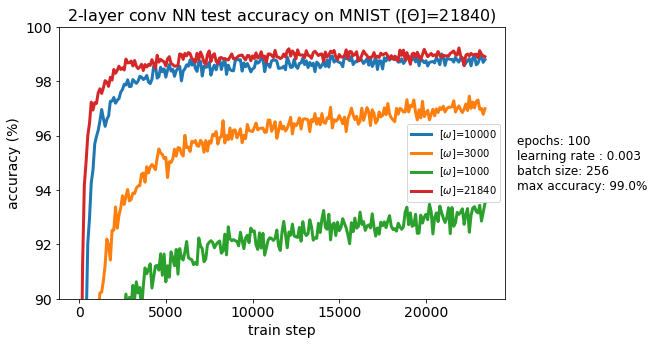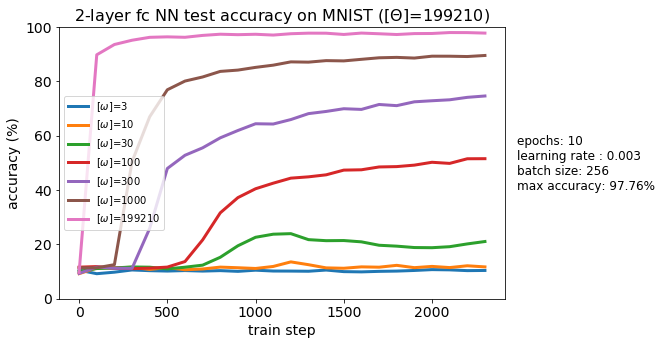Sam Greydanus. October 2017. MIT License. Blog post
Written in PyTorch
We train several MNIST classifiers. We introduce subspace optimization on some of them. The idea is to optimize a weight space (call this 'omega space') of, say, 1000 parameters and then project these parameters into the full space (call this 'theta space') of, say, 200,000 parameters. We're interested in studying the convergence properties of this system.
- subspace-nn-conv: a 784 -> (10,5x5) -> (20,5x5) -> 50 -> 10 MNIST classifier implemented in PyTorch with subspace optimization. Optimization occurs in this low dimensional space (omega space), and then the weights are projected into the full parameter space (theta space). We train in subspaces of dimension [3, 10, 30, 100, 300, 1000] and compare to a model trained in full (theta) parameter space.
- subspace-nn-fc: a 784 -> 200 -> 200 -> 10 MNIST classifier implemented in PyTorch with subspace optimization. Optimization occurs in this low dimensional space (omega space), and then the weights are projected into the full parameter space (theta space). We train in subspaces of dimension [3, 10, 30, 100, 300, 1000] and compare to a model trained in full (theta) parameter space.
- mnist-zoo: several lightweight MNIST models that I trained to compare them with the models I optimized in 'omega space':
| Framework | Structure | Type | Free parameters | Test accuracy |
|---|---|---|---|---|
| PyTorch | 784 -> 16 -> 10 | Fully connected | 12,730 | 94.5% |
| PyTorch | 784 -> 32 -> 10 | Fully connected | 25,450 | 96.5% |
| PyTorch | 784 -> (6,4x4) -> (6,4x4) -> 25 -> 10 | Convolutional | 3,369 | 95.6% |
| PyTorch | 784 -> (8,4x4) -> (16,4x4) -> 32 -> 10 | Convolutional | 10,754 | 97.6% |
- All code is written in Python 3.6. You will need:
- NumPy
- Matplotlib
- PyTorch 0.2: easier to write and debug than TensorFlow :)
- Jupyter

